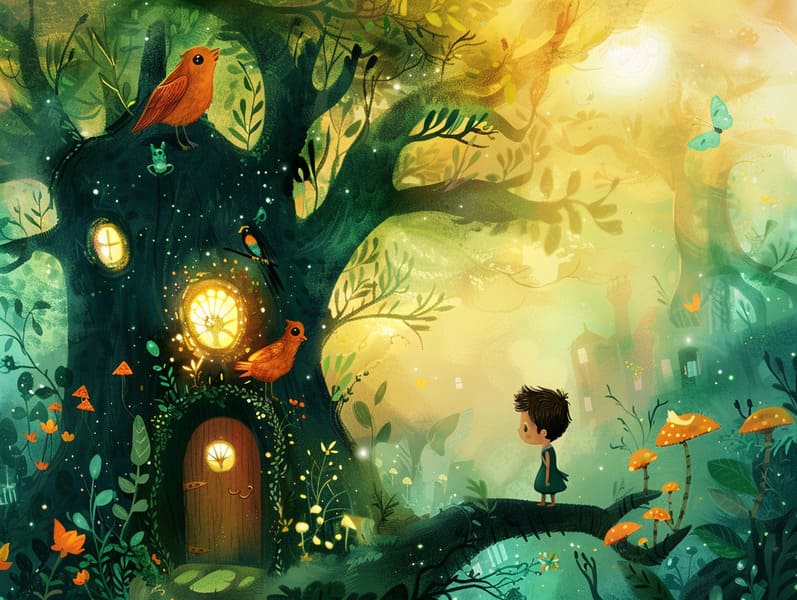
Popular fairy tales have historical significance. These stories have been whispered from one generation to the next millennia before they were ever recorded. They developed from a variety of backgrounds, including Western traditions. They were initially narrated among grown-ups, often carrying themes and messages pertaining to the societal norms and beliefs of the time.
Jacob and Wilhelm Grimm, Jacob and Wilhelm (the Grimm brothers), were among the first to compile and publish many of these beloved fairy tales. Their collection, "Grimm's Fables," included narratives like "Cinderella," "Little Brother and Little Sister," and "The True Story of Snow White," which have since become staples in the world of timeless fairy tales. Similarly, Hans Christian Andersen's imaginative tales, such as "The Mermaid," and "The Duckling's Story," have touched hearts worldwide, establishing their place in the pantheon of beloved fairy tales.
Though they are old, classic fairy tales remain as relevant as ever, especially as nighttime stories for kids. These whimsical stories are now available in numerous formats, including vibrantly illustrated books, enchanting animations, and digital fairy tales.
Their lasting appeal can be attributed to several fascinating points:
Vital Lessons: Classic fairy tales often provide important moral lessons. Tales like "The Wolf and the Liar" teach the virtue of truthfulness, while "The Tale of the Tortoise and the Hare" exemplify the traits of determination and unassuming nature. These narratives offer young ones clear distinctions between truth and falsehood, building their moral compass in a kind yet impactful way.
Compassion and Insight: Fairy tales frequently illustrate protagonists facing trials and tribulations, prompting readers to connect with their struggles and celebrate their triumphs. For instance, "Beauty's Beast" shows us the benefit of seeing inner beauty to recognize the real character of a individual, developing perception and comprehension.
Cultural Perception: Many old fairy tales are rich in the cultural contexts from which they grew. Learning from these fairy tales can provide enlightening views into different heritages, cultivating a sense of international awareness and discernment.
Fantasy and Imagination: The supernatural elements in timeless fairy tales—magical kingdoms—ignite children’s visions. These stories guide readers to fantasy realms, activating fantasy ideas and a sense of delight that continues a lifetime.
Timeless fairy tales are not only captivating but also informative. They work as mesmerizing tools in fostering various mind and heart abilities in kids. When classic fairy tales are spoken, they strengthen language proficiency by introducing new words and elaborate sentence structures. This practice also nurtures hearing perception and focus, as children concentrate deeply, keen to see what happens next.
Furthermore, discussing the themes and characters of old fairy tales can advance thinking skills and analytical skills. The young are educated to find patterns, expect results, and understand cause and effect. These discussions also assist little ones speak out their thoughts and feelings, adding to their emotional intelligence.
In today’s digital age, the accessibility of web-based fairy tales has made these narratives more reachable than ever. Web-based platforms and programs make available extensive collections of children's fairy tales that can be explored or listened via anytime, anywhere. Fairy tales voiced are particularly well-liked, extending an fun way for little ones to be a part of these spellbinding stories. Audio stories and read-out-loud videos bring characters and settings to life, often accompanied by mesmerizing musical scores and musical scores that raise the narrative journey.
The unfading fascination of timeless fairy tales lies in their ability to modify to modern society while keeping hold of their central values. Contemporary modernizations of these narratives often showcase more diverse figures and modern settings, making them relatable to today’s audience. However, the main ideas of courage, understanding, and fair-mindedness remain unchanged, continuing to affect kids of all ages.
Classic fairy tales also offer a sense of peace and closeness. They grant a well-arranged narrative with a plain beginning, middle, and end, often wrapping up with the ending of conflicts and the triumph of goodness over badness. This regularity can be placating for kids, spreading a sense of steadiness in an ever-changing world.
Timeless fairy tales continue to entrance and instruct new generations, maintaining their magic and impact in modern society. As children's bedtime stories, they extend a perfect blend of wonder and wisdom, facilitating moral values, empathy, and creativity. The presence of internet fairy tales and the likability of fairy tales narrated confirm that these traditional tales remain accessible to new generations.
By continuing and distributing these fairy tales, we continue to praise the rich tapestry of human imagination and cultural heritage. Whether you are enjoying a artistically illustrated book, browsing a online collection, or listening to an voice book, the wonder of timeless fairy tales is always within reach. These fairy tales illustrate of the enduring effect of narratives and its ability to bind us across centuries and lands.
Regardless if you are seeing a gorgeously illustrated book, delving into a online collection, or listening via an voice book, the charm of famous fairy tales is always within reach.
These fairy tales teach us of the find it here eternal power of narratives and its ability to tie us across generations and cultures, weaving a spell that delights and instructs alike.